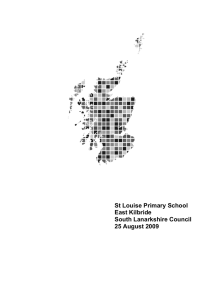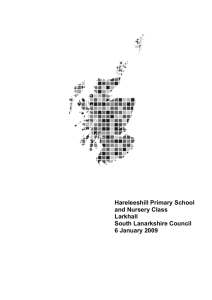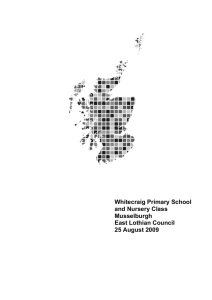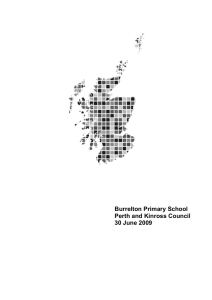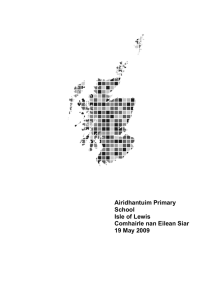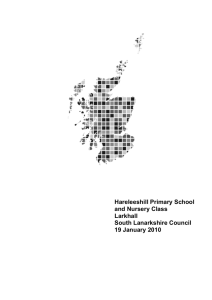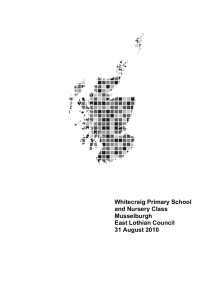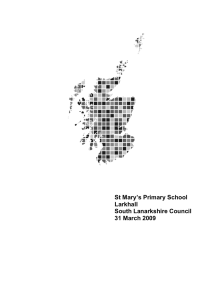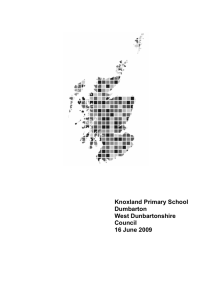Dunrossness Primary School and Nursery Class Shetland Islands Council
advertisement
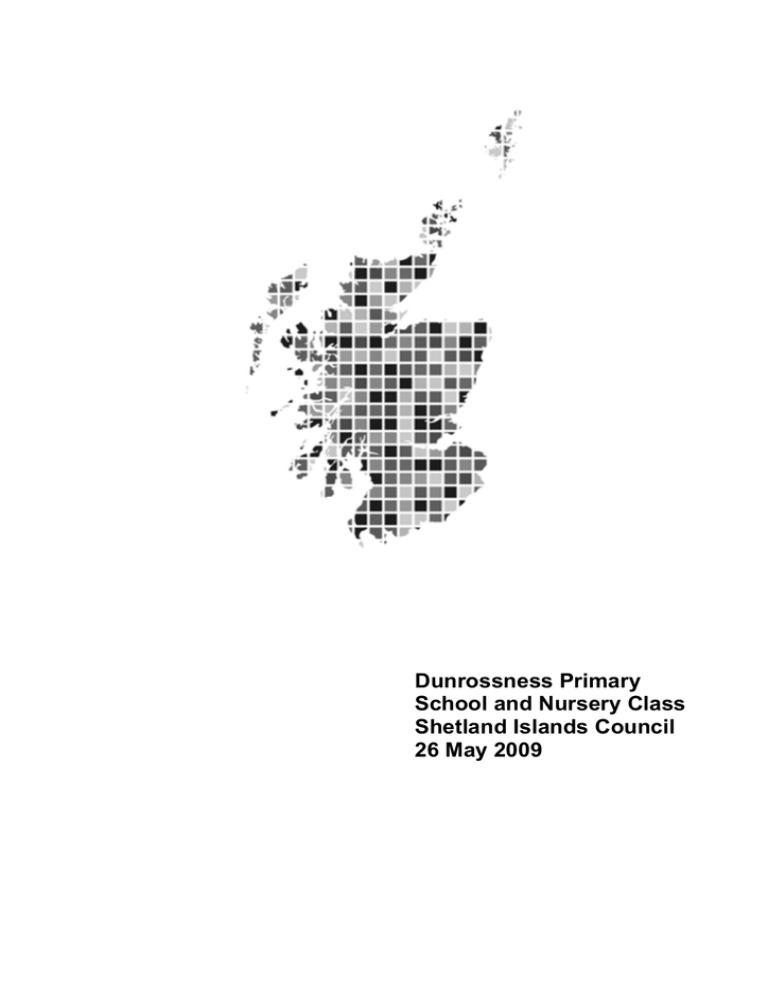
Dunrossness Primary School and Nursery Class Shetland Islands Council 26 May 2009 This report tells you about the quality of education at the school1. We describe how children benefit from learning there. We explain how well they are doing and how good the school is at helping them to learn. Then we look at the ways in which the school does this. We describe how well the school works with other groups in the community, including parents2 and services which support children. We also comment on how well staff and children work together and how they go about improving the school. Our report describes the ‘ethos’ of the school. By ‘ethos’ we mean the relationships in the school, how well children are cared for and treated and how much is expected of them in all aspects of school life. Finally, we comment on the school’s aims. In particular, we focus on how well the aims help staff to deliver high quality learning, and the impact of leadership on the school’s success in achieving these aims. If you would like to learn more about our inspection of the school, please visit www.hmie.gov.uk. Here you can find analyses of questionnaire returns. Where applicable, you will also be able to find descriptions of good practice in the school. 1 2 The term ‘school’ is used to include the work of the nursery class, where relevant. Throughout this report, the term ‘parents’ should be taken to include foster carers, residential care staff and carers who are relatives or friends. Contents 1. The school 2. Particular strengths of the school 3. Examples of good practice 4. How well do children learn and achieve? 5. How well do staff work with others to support children’s learning? 6. Are staff and children actively involved in improving their school community? 7. Does the school have high expectations of all children? 8. Does the school have a clear sense of direction? 9. What happens next? 1. The school Dunrossness Primary School is a non-denominational school with a nursery class. It serves several rural communities in the South Mainland area of Shetland. The roll was 121, including 20 in the nursery when the inspection was carried out in March 2009. Pupils’ attendance was in line with the national average in 2007/08. 1 2. Particular strengths of the school • Responsible children who support each other in a variety of school initiatives. • The involvement of parents in improving experiences for children. • The commitment of staff to improving children’s experiences and wider achievements. • Effective approaches to self-evaluation. • The development of leadership for learning by the headteacher. 3. Examples of good practice • Parental involvement in learning. • The school’s approaches to improving self-evaluation. 4. How well do children learn and achieve? Learning and achievement Children in the nursery take part enthusiastically in their learning. They are learning to work together in small groups, and cooperate well with their friends. Almost all children are making good progress in their development and learning. They take part in conversations with ease, and listen carefully to instructions. Children can recognise and write their own name. They are good at counting, can describe simple 2 shapes and are learning about time in their everyday routines. Across the primary classes, children are enthusiastic and proud of their achievements. Most children are well motivated and try to do their best. They learn well by being actively involved in tasks which encourage them to think for themselves. Children at P2/P3 have used their number skills to collect data and make graphs of the most popular fruits across the school. Children are learning to work together in groups and make helpful comments about each other’s work. Those at P6 help to improve each other’s personal projects on volcanoes. Children in the school achieve well through their involvement in after-school clubs, lunchtime activities, choir and instrumental tuition. They enjoy being helpers and taking part in school committees such as the eco committee and the pupil council. They have helped the school gain their first Eco-Schools Scotland flag. Children are gaining responsibility and increasing their active citizenship skills by taking part in many charity events and collections. They are making very good progress in English language and in mathematics. Over the last few years the school has steadily improved attainment in reading and mathematics. Some children at P2 and P7 are achieving national attainment levels earlier than would normally be expected. The school is taking steps to address the drop in writing attainment from the previous year. Most children listen attentively to their teacher and in groups and contribute well to discussion. Almost all enjoy reading and read confidently at their level. Children in P6 work with their younger partner in P2 to encourage reading. Children write for a good range of purposes. At P2/P3 children wrote well when describing a visit from a specialist from Edinburgh Zoo. In mathematics, all children enjoy learning in practical lessons and are able to find information from graphs and tables. They are quick at mental mathematics and accurate in their written work. They would benefit from more active problem solving activities and discussion of their solutions. Staff are beginning to plan more effective links between mathematics and other areas in their topic work. 3 Curriculum and meeting learning needs Nursery staff provide a very good range of activities which support children well in their learning and development. They have started to take account of the national initiative, Curriculum for Excellence, in their planning of early literacy and numeracy in children’s play. Staff are involving children more by asking their views about what they enjoy in their learning. Regular sessions between the nursery and P1 help children progress smoothly from nursery into the primary school. Some of these early experiences need to be reviewed to ensure all activities are relevant and meaningful. Across the primary classes, staff promote healthy lifestyles and encourage children to make healthy food choices. Teachers are beginning to use the outcomes from a Curriculum for Excellence in their planning of children’s learning. This is resulting in improved experiences for children particularly in science and social studies, health and sustainability. Staff help children to see the relevance of their learning by visiting places of interest such as the local meteorological station and the wind turbines at Buradale. This was part of their weather and climate change project. Recent improvements to resources for information and communications technology (ICT) allow children to use ICT more frequently in their class. Interactive whiteboards are used well by some teachers to improve teaching experiences for children. Children in P7 have younger buddies in P1 and work together on ICT projects. Staff are improving how they involve children in setting individual learning targets in writing and mathematics. All children experience two hours high quality physical education including weekly swimming lessons. Staff in the nursery provide a caring learning environment which meets children’s needs effectively. They know children very well and involve them in planning learning activities. Across the primary classes most tasks and resources are appropriate and motivating. Children would benefit from more opportunities to take responsibility for, and be actively involved in, their learning. Staff are consistent and effective in the way they support children who need extra help with their learning. The acting principal teacher consults and works effectively with 4 children, staff and parents to meet the needs of individual children. Learning assistants work well within classes and provide sensitive, well-targeted help. Fortnightly meetings take place to review targets for children’s learning and help to ensure that children make good progress with their learning. 5. How well do staff work with others to support children’s learning? Staff have formed effective partnerships with a range of agencies to help improve children’s learning. The speech and language therapist and the educational psychologist provide staff with helpful information. They often work directly with children to help them make good progress. The school communicates regularly with parents through newsletters, its website, parents’ evenings and an annual written progress report. Parents have been involved in a very successful pilot project in a class to better involve them in their child’s learning. The headteacher has improved the school’s arrangements for responding to complaints from parents and children. The Parent Council is providing good support and is working with staff on a number of priorities to improve the school. Teachers have recently improved homework to make it more relevant and exciting for children. Children and parents are involved in a wide range of activities to improve the school and encourage a healthy lifestyle. Staff organise family workshops on a Saturday morning including gardening projects, digital photography and table tennis. Children are well supported in their move to secondary school through several events and meetings with staff and children from other schools. 6. Are staff and children actively involved in improving their school community? Children enjoy taking responsibilities across the school. They are developing a sense of citizenship and speak enthusiastically about taking part in the pupil council, the health and eco-committee. They 5 feel that representatives are chosen fairly and equally. All staff contribute well to improving experiences for children. The janitor has set up a web cam with the children to study nesting birds. The school cook has been involved with children to decide which vegetables to grow in the poly tunnel. The headteacher has established a system to allow staff to visit classes to learn from each other. The school improvement plan has helped to improve aspects of children’s learning such as writing. Staff work very well together and all play a part in taking forward developments in the school improvement plan. Children, parents and staff have recently been involved in reviewing the school aims and motto to make these more relevant. 7. Does the school have high expectations of all children? Children are proud of their school. They have very good opportunities to visit the surrounding area and have regular visitors such as an archaeologist in P3/P4 to help with their topics. Children are encouraged to help each other out in classes and in the playground. They feel they can share their concerns confidentially if they are worried or upset. Staff are highly committed to the wellbeing and support of all children. Achievements both inside and outwith school are a feature of weekly school assemblies. Wall displays are attractive and encourage the achievement of all children. Staff have an appropriate awareness of child protection procedures. Office staff in particular,are vigilant in taking appropriate action if children are absent from school without explanation. Children of all ages are encouraged to take on leadership roles. In the nursery they are encouraged to be responsible, take turns and share resources. In the primary classes staff use a range of ways to encourage children to be well behaved. P5 children are taking part in a peer mediation project to encourage tolerance and respect for each other. 8. Does the school have a clear sense of direction? The headteacher has a clear sense of direction. She has correctly 6 identified areas for improvement in the school and takes a strong lead in curriculum development. She is highly respected by children, staff and parents. She has focussed well on improving learning for children since her appointment last session. The acting principal teacher carries out her work effectively. She helps children improve their learning and provides very good support to staff and learning assistants. The recent focus on self-evaluation by the headteacher is helping staff to improve their teaching. Staff receive valuable comments on their forward plans which in turn allows them to adapt their activities for children’s learning. They are becoming more reflective of their practice and in discussion with others, adapt and change their teaching to improve learning for children. Staff have additional opportunities to discuss children’s progress with the headteacher and with children in their class. Regular classroom visits take place, which support and challenge staff and result in children making better progress in learning. The school is well placed to continue to improve. 7 9. What happens next? As a result of the very good quality of education provided by the school, we will make no further visits following this inspection. The education authority will inform parents about the school’s progress as part of the authority’s arrangements for reporting to parents on the quality of its schools. We have agreed the following area for improvement with the school and education authority. • Update guidance on teaching and learning for staff in line with a Curriculum for Excellence and further develop active learning opportunities for children at all stages At the last Care Commission inspection of the nursery class four recommendations were made, all of which have been addressed. 8 Quality indicators help schools and nursery classes, education authorities and inspectors to judge what is good and what needs to be improved in the work of a school and a nursery class. You can find these quality indicators in the HMIE publications How good is our school? and The Child at the Centre. Following the inspection of each school, the Scottish Government gathers evaluations of three important quality indicators to keep track of how well all Scottish schools and nursery classes are doing. Here are the evaluations for Dunrossness Primary School and Nursery Class. Primary school Improvements in performance Learners’ experiences Meeting learning needs very good very good very good Nursery class Improvements in performance Children’s experiences Meeting learning needs very good very good very good We also evaluated the following aspects of the work of the school and nursery class. The curriculum Improvement through self-evaluation HM Inspector: Elizabeth Paterson 26 May 2009 9 good very good To find out more about inspections or get an electronic copy of this report go to www.hmie.gov.uk. Please contact the Business Management and Communications Team (BMCT) if you wish to enquire about our arrangements for translated or other appropriate versions. If you wish to comment about any of our inspections, contact us at HMIEenquiries@hmie.gsi.gov.uk or alternatively you should write in the first instance to BMCT, HM Inspectorate of Education, Denholm House, Almondvale Business Park, Almondvale Way, Livingston EH54 6GA. Our complaints procedure is available from our website www.hmie.gov.uk or alternatively you can write to our Complaints Manager, at the address above or by telephoning 01506 600259. If you are not satisfied with the action we have taken at the end of our complaints procedure, you can raise your complaint with the Scottish Public Services Ombudsman (SPSO). The SPSO is fully independent and has powers to investigate complaints about Government departments and agencies. You should write to SPSO, Freepost EH641, Edinburgh EH3 0BR. You can also telephone 0800 377 7330, fax 0800 377 7331 or e-mail: ask@spso.org.uk. More information about the Ombudsman’s office can be obtained from the website at www.spso.org.uk. This report uses the following word scale to make clear judgements made by inspectors. excellent very good good satisfactory weak unsatisfactory outstanding, sector leading major strengths important strengths with some areas for improvement strengths just outweigh weaknesses important weaknesses major weaknesses Crown Copyright 2009 HM Inspectorate of Education
